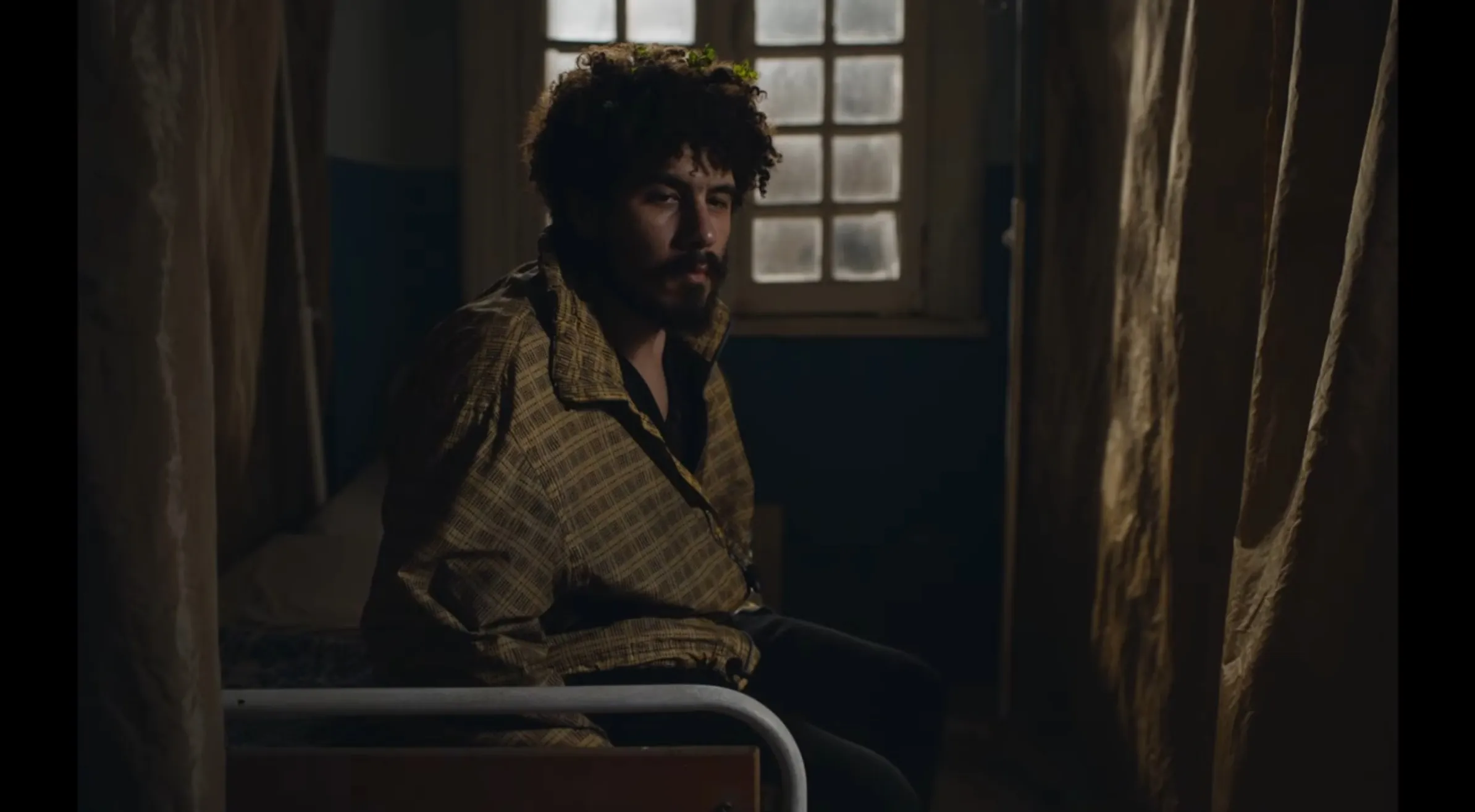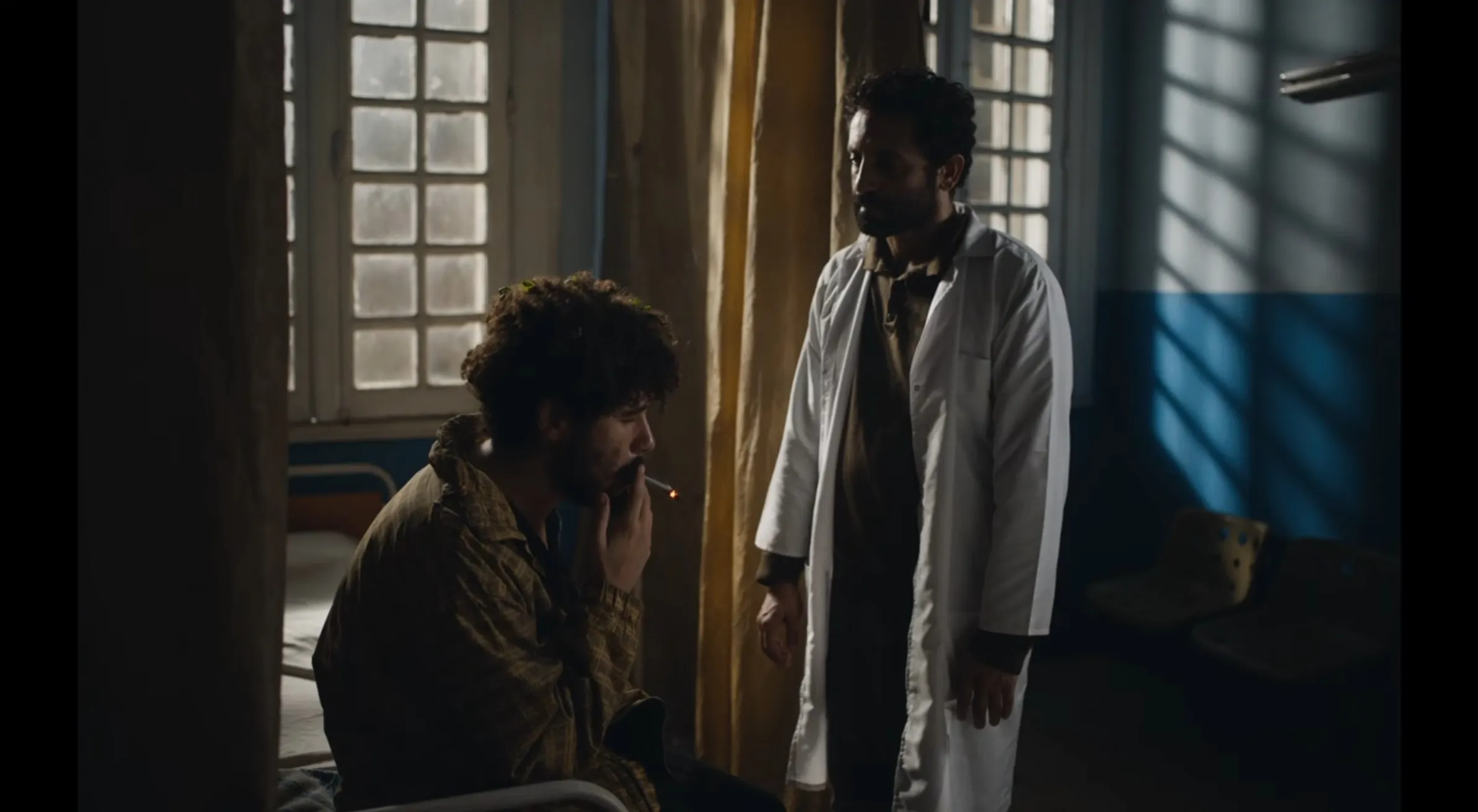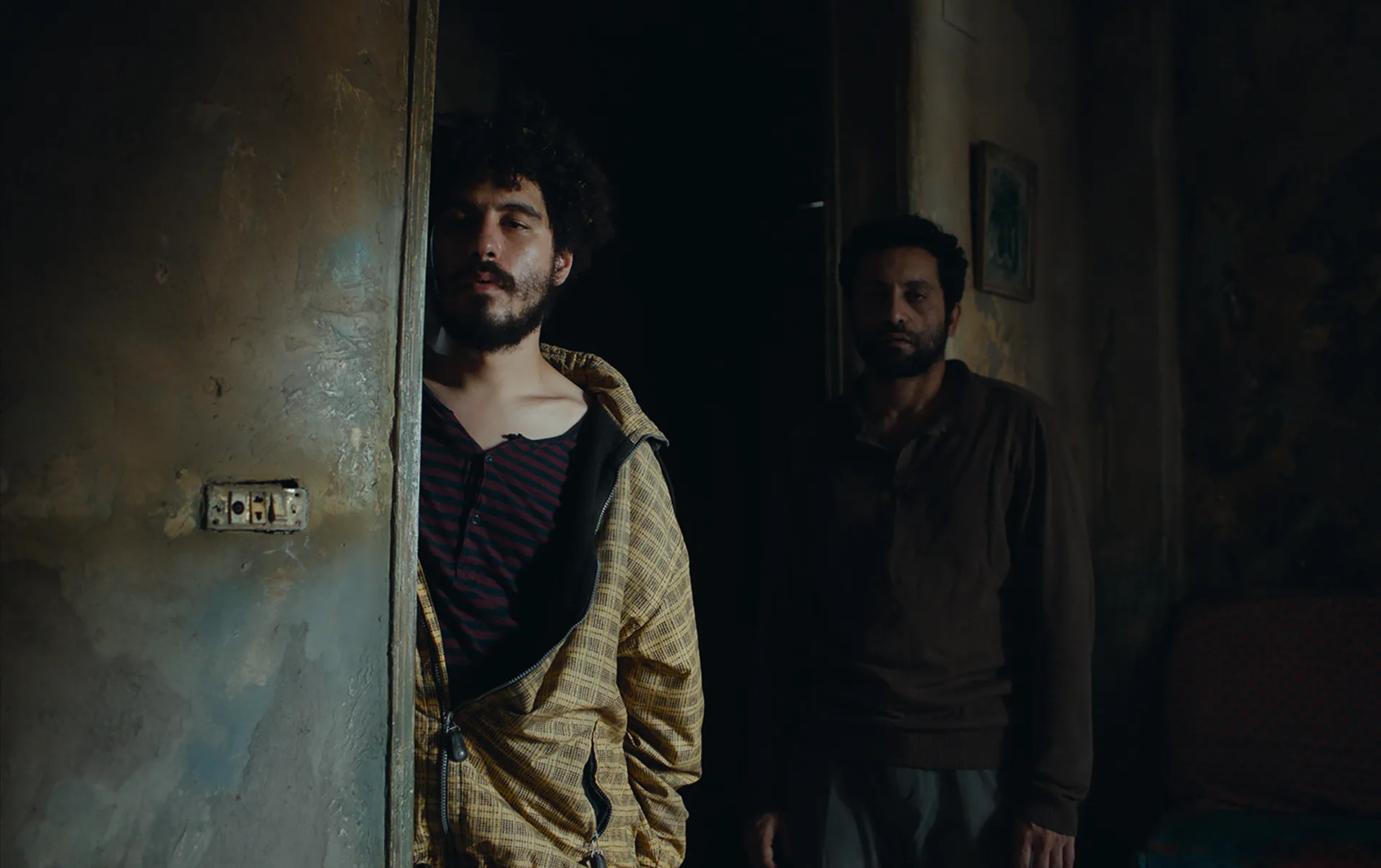Muhammed Hamdy’s directorial debut Perfumed With Mint, released in 2024, tells a surreal tale of trauma lingering long after its causes have faded. Set in a decaying, unnamed Egyptian city, the film follows Bahaa, a doctor struggling with his own loss, and his friend Mahdy, whose body sprouts mint in times of fear or anxiety.
Wandering the city’s dark streets and abandoned buildings, they encounter others scarred by past events, living half in the present and half in haunting memories of what came before.
Through evocative imagery and languid pacing, Hamdy crafts a dreamlike world where reality and memory blur together. His static camera lingers in shadows as characters speak of private fears and political unrest. Under the surreal surface lies a profound meditation on how the past refuses to release its hold.
With its gorgeous cinematography and atmosphere of quiet unease, Perfumed With Mint invites us into lives disrupted by invisible wounds and offers no easy answers, only the hope that in bearing witness, we move closer to understanding.
Lost Souls in a City of Shadows
At the center of Perfumed With Mint are Bahaa and Mahdy, two souls haunted by ghosts of the past. Bahaa works as a doctor but struggles with private wounds of his own—namely, the loss of his love Dalel years ago. All that remains is a letter from her that, after getting wet, refuses to fully dry.
Mahdy deals with an unusual affliction—when scared or anxious, mint emerges unbidden from his skin. To dull this curse, the friends self-medicate with hashish, wandering the crumbling buildings of their unnamed city as it falls into ruin around them.
They’re not alone in this melancholy exile. Other figures surface, all seeming to materialize from some “physical expression or manifestation of trauma.” One bears 171 phantom bullet holes; another finds prayer an unwanted intrusion.
Hamdy’s surreal touches like Mahdy’s mint or Bahaa’s weeping letter blend fantasy and reality as these broken spirits drift between worlds. Are they ghosts haunting one another, or the living haunted by what’s past? No firm lines exist in their purgatory of abandoned shelters and smoke-filled rooms.
Under dreamlike surfaces lie very real themes of loss, absence, and paranoia. A generation scarred by turmoil finds no solace, only more questions. What did they lose, and how? How does one resume a life in a country changed beyond recognition? In these souls suspended between past and future, Hamdy finds a portrait of a nation also adrift.
Hamdy’s Haunting Visual Vision
With Perfumed With Mint, Muhammed Hamdy steps into the director’s chair for the first time. But he arrives bearing strong credentials from his past work behind the camera, including earning an Emmy for cinematography on The Square.
Straight away, it’s clear Hamdy is in full command of his visual storytelling. He envelops the film in a shroud of gloom and shadow that perfectly sets the dreary tone. Scenes unfold beneath a thick cloak of darkness, streaks of murky light the sole thing breaking the heavy mood.
More than just creating beauty through bleakness, Hamdy has crafted a unique visual language. Shadows loom as ominous shades, ready to manifest memories. Carefully composed frames place characters amid labyrinths of black, blurring lines between what’s real and remembered.
Fitting a film about torment, his deliberate pace lets scenes linger and fester. Static cameras hold as monologues unveil private pains. It’s a style echoing the slow unraveling of trauma over years rather than its flashier moments.
Minimalist design becomes poetic too. Every footstep echoes in sparse sets; every figure stands out amid emptiness. Combined with unobtrusive work from his sound crew, it draws us deep into this haunted world.
From haunting tracking shots to faces emerging from inky corners, Hamdy draws us into a nightmare through pure imagination and technique. Even for those cold to its bleak themes, Perfumed With Mint offers a feast for the eyes and ears in its director’s masterful grasp of atmosphere. A perfect marriage of artistry and story, it announces a visionary talent at the helm.
Lingering Wounds of Revolution
There’s no ignoring the political context permeating Perfumed With Mint. Hamdy’s characters drift with a disillusionment all too familiar to many post-Arab Spring.
Just over a decade since Cairo’s Tahrir Square erupted with hope, the men wandering Hamdy’s city seem to have little left. Where once was doubt but desire for change, now there’s only defeat. Too many revolutions traded one tyrant for another, leaving old wounds to fester.
So they opt not to face hard truths but lose themselves in hash smoke. Anything to dull painful memories of those lost or sacrificed. Some sprout mint as living reminders of trauma, trying in vain to outrun ghosts of the past.
It’s no mystery why. Hamdy captures a generation scarred by turmoil, left exhausted from protesting what feels like futility. After trading Hosni Mubarak for the likes of Mohamed Morsi and Abdel Fattah el-Sisi, what’s left but to limp on in aimlessness?
This elegy understands little has truly healed. When this longed-for “living” seems impossible, intoxication and fantasy become the sole escapes. A country changes beyond recognition, but injuries from what came before still plague its people.
Underneath its mellow tones, Perfumed With Mint carries a salient political message. Of revolutions that rearranged faces in power while leaving deeper scars to fester, and a still-struggling nation filled with lost souls like Bahaa and Mahdy. Their plight reflects a crisis in many who haven’t stopped protesting, even if in muted ways, as each movement’s call seems further muted.
Shadows of the Past, Shadows of the Mind
Perfumed With Mint provoked varied discussion among audiences. Some found Hamdy’s deliberate pace taxing rather than purposeful. His characters’ disillusioned air led others to judge them too passively numb to oppression.
Yet ambiguity is just what Hamdy wants. No firm lines exist here between literal and metaphorical. Are the city’s drifting souls ghosts, or only haunted living? Do they flee some “whistle” in reality, or the ceaseless caws of memory?
All interpretations hold merit. Hamdy leaves mysteries unsolved, for the mind continually sees what it brings. His crowded yet empty frames invite contemplation more than explanation. We can almost see the past shimmer and emerge from his inky shadowscapes, much as it springs unbidden to the film’s scarred figures.
By refusing pat resolutions, Hamdy mirrors the messy workings of trauma itself. Sometimes the ghosts are outside, sometimes within. The nature of hauntings shifts with the watcher as with the watched.
Perfumed With Mint offers no easy catharsis, only the hope that grappling with its quiet unease brings deeper understanding—of how nations and individuals endure invisible wounds whose scars may never fade. Some stay to reflect, while others storm off, restless, seeking answers. Hamdy keeps submerged in misty memory-dreams. Both responses feel fitting for this poetic meditation on the past’s refusal to die and the imagination’s power to keep resurrecting it.
Perfumed With Mint’s Poignant Parting Gift
There’s no denying Hamdy’s talents for imagery—his spectral scenes are spellbinding. Darkness and mint leaves entwine in a rhythm that conveys a nation’s quiet unease perfectly.
Yet Perfumed With Mint hits lulls too. Early on, conversations drifting in sad circles feel overlong. The film risks losing some in repetitive debates about pain’s universality.
However, it blooms beautifully at the end. The climax unveils the aesthetic and meaning the film had been lacking, but fittingly so—its subjects exhaust themselves in a similar manner.
When movement comes, it’s a meditation rather than action. Visuals inquiring what becomes of a generation left to rot spiritually, their calls fading with each new revolution.
This poetic payoff rewards patience. The film submerges us deeply in trauma’s waters yet offers no lifejackets. Only through grappling with its melancholy can insight emerge into wounds that may never mend.
Far from a cure, Perfumed With Mint provides poignant company for those bearing invisible scars. In crafting such compelling ghosts, Hamdy has given a generation’s haunting backstory its due respect. His impactful debut announces an important new voice with vision to match his skills.
With great care taken of even small details, there is much to appreciate in this dreamlike and daring freshman work. It asks much of viewers but repays tenfold for those lingering in its lingering questions. An aching elegy to lives disrupted by ghosts refusal to release their grip.
A Poetic Portrait Worth Profound Contemplation
While Perfumed With Mint asks viewers to linger long in its shadowy depths, this haunting debut ultimately rewards such patience. We’ve discussed Hamdy’s masterful visuals, surreal touches, and nuanced commentary on lingering trauma—both personal and political.
Though sluggish starts and ambiguity may frustrate some, ambiguity is just what Hamdy wants. His dreamlike style mirrors messy realities, with answers as elusive as the specters haunting his characters. It challenges us as trauma challenges its subjects—but meaningful art seldom comforts easy.
As Hamdy’s first foray into directing, this film secures his place as an artist of immense vision and style. Egyptian or art house fans will find much to appreciate in its poetic portraiture of lost souls. Its unresolved qualities reflect real life’s refusal to provide neat conclusions.
For those open to contemplating profound wounds invisible to the eye, Perfumed With Mint offers a uniquely haunting elegy. Its discontent lingers long after, questioning specters we’d rather not face and stirring insight worth finding. Hamdy’s debut demands we see hard truths and recognize grief’s many shapes, for only then can understanding—of others and ourselves—begin to bloom.
The Review
Perfumed with Mint
Though not without flaws, Perfumed With Mint reveals a director of immense talent in Muhammed Hamdy. His gift for atmosphere and imagery immerses viewers in a dreamlike world where memories and reality fade together. Under surreal surfaces lies a profound meditation on personal and political trauma that has yet to release its hold. Perfumed With Mint demands patience but repays with lingering questions that stir insight long after its final frames.
PROS
- Evocative visuals and masterful use of lighting, shadow, and mood
- Authentic and haunting portrayal of PTSD/trauma in characters
- Surreal elements lend a dreamlike quality that enhances themes.
- Provokes thought on political and personal wounds that refuse healing
- Ambiguous and open to interpretation, mirroring nature of memory
CONS
- Pacing is deliberately slow, and some scenes feel too protracted.
- Early repetitive conversations risk losing less patient viewers.
- Surreal elements may confuse or frustrate those seeking clarity.
- Downbeat tone and characters may not appeal to all audiences.





















































